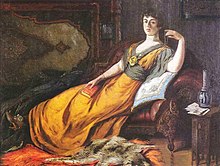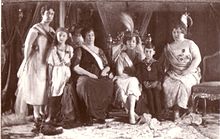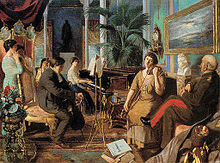Şehsuvar Hanım
| Şehsuvar Hanım | |||||
|---|---|---|---|---|---|
 An 1898 painting of Şehsuvar Hanım, painted by her husband | |||||
| Born | c. 1881 | ||||
| Died | c. 1945 (aged 63–64) Paris, France | ||||
| Burial | |||||
| Spouse | |||||
| Issue | Şehzade Ömer Faruk | ||||
| |||||
| House | Ottoman (by marriage) | ||||
| Religion | Sunni Islam | ||||
Şehsuvar Hanım (Ottoman Turkish: شهسوار خانم; c. 1881 – c. 1945; meaning "intrepid hero"[1]) was the first wife of Abdulmejid II, the last Caliph of the Ottoman Caliphate.
Life[]
Of Turkish,[2] or Ubykh origin,[3] Şehsuvar Hanım was born in 1881.[4][3] She married Abdulmejid, at the age of fifteen, on 22 December 1896. Şehzade Ömer Faruk,[5] the couple's only son was born on 29 February 1898.[6][7][8]

Abdulmejid was interested in classical music. At times, he would perform with his wives, and the kalfas. He would be at the piano, Şehsuvar and Hayrünnisa Hanım would play the violin, and Mehisti Hanım the cello.[9]
At the exile of the imperial family, in March 1924, she followed her husband, firstly to Switzerland and then to France where they settled in Paris.[10] She could speak French,[11][2] and could understand English.[2]
In paintings[]

In an 1898 work by Abdulmejid, Pondering/Goethe in the harem, Şehsuvar is shown reclining on a settee.[12] However, according to an interview with Fatma Neslişah Osmanoğlu on 26 May 2002, she said that the figure does not resemble her paternal grandmother Sehsuvar Hanım.[13] In another work of 1915, Harmony of the Harem/Beethoven in the Harem, by her husband, she is shown playing a violin.[12]
Death[]
She died in 1945,[5] having outlived her husband by nearly one year, and was buried in the Muslim Bobigny cemetery in Paris.[4][6]
Issue[]
| Name | Birth | Death | Notes |
|---|---|---|---|
| Şehzade Ömer Faruk | 27 February 1898[6][14][8] | 28 March 1969[6][14] | married twice, and had issue, three daughters |
References[]
- ^ Argit, Betül Ipsirli (October 29, 2020). Life after the Harem: Female Palace Slaves, Patronage and the Imperial Ottoman Court. Cambridge University Press. p. 66. ISBN 978-1-108-48836-5.
- ^ Jump up to: a b c Moralı, Seniha Sami (1978). Meşrutiyet, Dolmabahçe Sarayı ve Ankara'nın İlk Günlerine Dair. p. 60.
- ^ Jump up to: a b Uçan 2019, p. 256.
- ^ Jump up to: a b Sakaoğlu 2008, p. 713.
- ^ Jump up to: a b Uçan 2019, p. 256-57.
- ^ Jump up to: a b c d Adra, Jamil (2005). Genealogy of the Imperial Ottoman Family 2005. pp. 37-38.
- ^ Bardakçı 2017, p. 21.
- ^ Jump up to: a b Uçan 2019, p. 261.
- ^ Bardakçı 2017, p. 114.
- ^ Bardakçı 2017, p. 203.
- ^ Bardakçı 2017, p. 109.
- ^ Jump up to: a b Wendy M. K. Shaw (March 15, 2011). Ottoman Painting: Reflections of Western Art from the Ottoman Empire to the Turkish Republic. I.B.Tauris. pp. 85–8. ISBN 978-1-848-85288-4.
- ^ Ömer Faruk Şerifoğlu (2004). Abdülmecid Efendi, Ottoman prince and painter. YKY. p. 103. ISBN 978-9-750-80883-8.
- ^ Jump up to: a b Bardakçı 2017, p. xvi.
Sources[]
- Bardakçı, Murat (2017). Neslishah: The Last Ottoman Princess. Oxford University Press. ISBN 978-9-774-16837-6.
- Uçan, Lâle (2019). Son Halife Abdülmecid Efendi'nin Hayatı - Şehzâlik, Veliahtlık ve Halifelik Yılları (PDF) (PhD Thesis). Istanbul University Institute of Social Sciences.
- 1881 births
- 1945 deaths
- Ottoman dynasty
